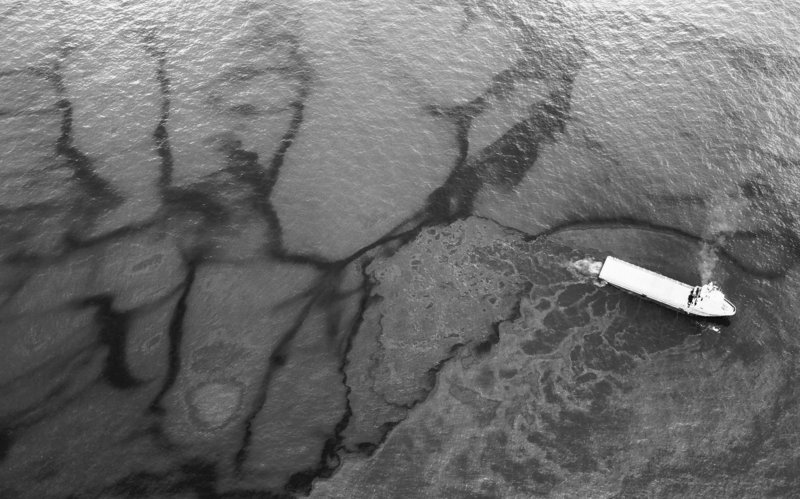NEW ORLEANS – The best hope for stopping the flow of oil from the blown-out well at the bottom of the Gulf of Mexico has been compared to hitting a target the size of a dinner plate with a drill more than two miles into the earth, and is anything but a sure bet on the first attempt.
Bid after bid has failed to stanch what has already become the nation’s worst-ever spill, and BP PLC is readying another attempt as early as Wednesday, this one a cut-and-cap process to put a lid on the leaking wellhead so oil can be siphoned to the surface.
But the best-case scenario of sealing the leak is two relief wells being drilled diagonally into the gushing well – tricky business that won’t be ready until August.
“The probability of them hitting it on the very first shot is virtually nil,” said David Rensink, incoming president of the American Association of Petroleum Geologists, who spent most of his 39 years in the oil industry in offshore exploration. “If they get it on the first three or four shots, they’d be very lucky.”
For the bid to succeed, the bore hole must precisely intersect the damaged well. If it misses, BP will have to back up its drill, plug the hole it just created, and try again.
TRIAL-AND-ERROR PROCESS
The trial-and-error process could take weeks, but it will eventually work, scientists and BP said. Then engineers will then pump mud and cement through pipes to ultimately seal the well.
As the drilling reaches deeper into the earth, the process is slowed by building pressure and the increasing distance that well casings must travel before they can be set in place.
Still, the three months it could take to finish the relief wells — the first of which started May 2 — is quicker than a typical deep well, which can take four months or longer, said Tad Patzek, who chairsf the Petroleum and Geosystems Engineering Department at the University of Texas-Austin. BP already has a good picture of the different layers of sand and rock its drill bits will meet because of the work it did on the blown-out well.
On the slim chance the relief well doesn’t work, scientists weren’t sure exactly how much — or how long — the oil would flow. The gusher would continue until the well bore hole collapsed or pressure in the reservoir dropped to a point where oil was no longer pushed to the surface, Patzek said. “I don’t admit the possibility of it not working,” he said.
A third well could be drilled if the first two fail.
HOW MUCH OIL?
“We don’t know how much oil is down there, and hopefully we’ll never know when the relief wells work,” BP spokesman John Curry said.
The company was starting to collect and analyze data on how much oil might be in the reservoir when the rig exploded April 20, he said.
BP’s uncertainty statement is reasonable, given they only had drilled one well, according to Doug Rader, an ocean scientist with the Environmental Defense Fund.
Two relief wells stopped the world’s worst peacetime spill, from a Mexican rig called Ixtoc 1 that dumped 140 million gallons off the Yucatan Peninsula. That plug took nearly 10 months beginning in the summer of 1979. Drilling technology has vastly improved since then, however.
So far, the Gulf oil spill has leaked between 19.7 million and 43 million gallons, according to government estimates.
In the meantime, BP is turning to another risky procedure federal officials acknowledge will likely, at least temporarily, cause 20 percent more oil — at least 100,000 gallons a day — to add to the gusher.
Using robot submarines, BP plans to cut away the riser pipe this week and place a cap-like containment valve over the blowout preventer. The company hopes it will capture the majority of the oil, sending it to the surface.
“If you’ve got to cut that riser, that’s risky. You could take a bad situation and make it worse,” said Ed Overton, a Louisiana State University professor of environmental sciences.
The latest attempt to capture the well comes after BP failed to plug the leak Saturday with its top kill, which shot mud and pieces of rubber into the well but couldn’t beat back the pressure of the oil.
NO WORSE LOCATION
The location of the spill couldn’t be worse:
• To the south lies an essential spawning ground for imperiled Atlantic bluefin tuna and sperm whales.
• To the east and west lie coral reefs and the coastal fisheries of Florida, Alabama, Mississippi and Texas.
• And to the north, Louisiana’s coastal marshes.
More than 125 miles of Louisiana coastline already have been hit with oil. “It’s just killing us by degrees,” said Tulane University ecologist Tom Sherry.
Send questions/comments to the editors.



Success. Please wait for the page to reload. If the page does not reload within 5 seconds, please refresh the page.
Enter your email and password to access comments.
Hi, to comment on stories you must . This profile is in addition to your subscription and website login.
Already have a commenting profile? .
Invalid username/password.
Please check your email to confirm and complete your registration.
Only subscribers are eligible to post comments. Please subscribe or login first for digital access. Here’s why.
Use the form below to reset your password. When you've submitted your account email, we will send an email with a reset code.